
A Practical Guide to Buying a Dead Body Bag Online
Why Understanding Dead Body Bags Is Critical for Modern Funeral Operations
A dead body bag is a non-porous, leak-proof container designed to safely transport and temporarily store human remains while preventing fluid leakage and contamination. Also known as cadaver pouches or human remains pouches (HRP), these essential mortuary supplies have become increasingly important since the COVID-19 pandemic highlighted the need for proper containment protocols.
Key Dead Body Bag Specifications:
- Standard adult size: 36" x 90" (89 x 229 cm)
- Weight capacity: 200-1000 lbs depending on model
- Materials: LDPE, PVC, vinyl, or reinforced nylon
- Thickness: 6-25 mil for durability
- Features: Rust-proof zippers, ID tags, lifting handles
- Price range: $1.04-$8.50 per unit
- Usage: Single-use only, not reusable
The surge in demand during major events like pandemics and natural disasters has made online purchasing essential for funeral homes. Modern body bags serve multiple critical functions: they slow decomposition through oxygen restriction, provide infection control barriers, preserve forensic evidence, and ensure dignified transport of remains.
As Mortuary Cooler, a national-level mortuary cooler supplier with experience in mortuary equipment, I've worked with funeral homes across the country to understand their dead body bag procurement challenges and storage needs.
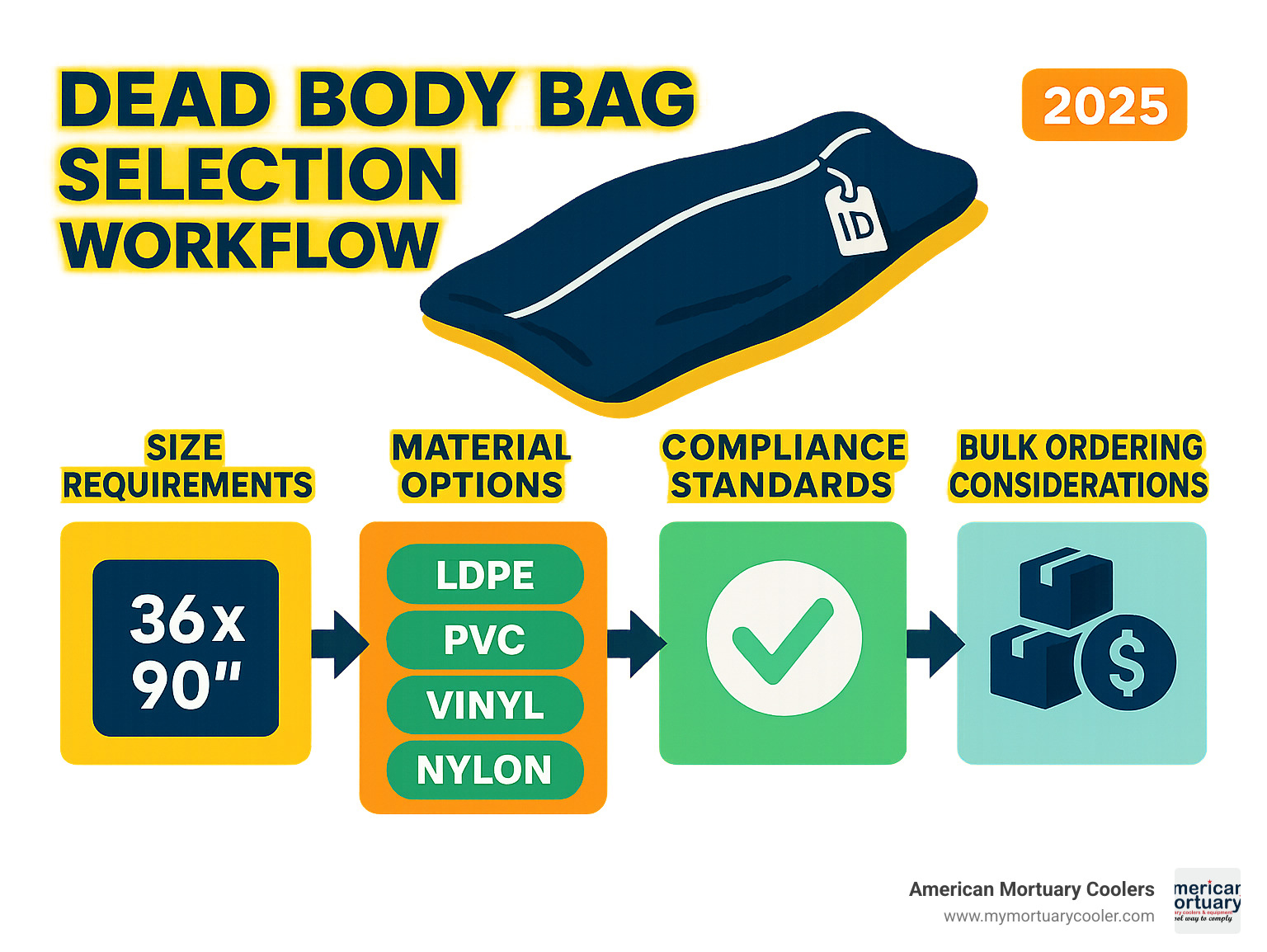
Relevant articles related to dead body bag:
What Is a Dead Body Bag? Origins, Purpose & Modern Roles
The dead body bag originated on Civil War battlefields when Dr. Thomas Holmes filed the first patent in 1863. What started as a desperate need to safely transport fallen soldiers has evolved into an essential tool for modern funeral homes and hospitals.
A dead body bag is essentially a waterproof pouch made from tough materials like vinyl or plastic that keeps bodily fluids contained while protecting the deceased from outside contamination. These aren't simple bags - they're engineered with rust-proof zippers, clear ID windows, and sturdy handles.
Modern body bags serve as cadaver pouches in hospitals, essential equipment for disaster response teams, and reliable containment systems for funeral homes. They slow decomposition by limiting oxygen exposure while creating barriers against insects and bacteria. For forensic investigations, this evidence protection capability is crucial.
Dead Body Bag vs. Traditional Shroud – Key Differences
Traditional shrouds serve ceremonial purposes but aren't designed for modern mortuary work challenges. The biggest difference is containment - shrouds are porous and absorb fluids, while dead body bags create complete waterproof seals preventing leakage during transport.
Fluid control becomes critical when moving remains between facilities. Body bags handle this with sealed seams and waterproof materials. The labeling capabilities include transparent ID windows and surfaces accepting permanent markers, ensuring proper identification and chain of custody.
Dead Body Bag in Mass-Fatality Events
The COVID-19 pandemic highlighted surge capacity needs when dead body bag suppliers saw orders increase by hundreds of percent. During natural disasters and catastrophic events, body bags become essential public health tools.
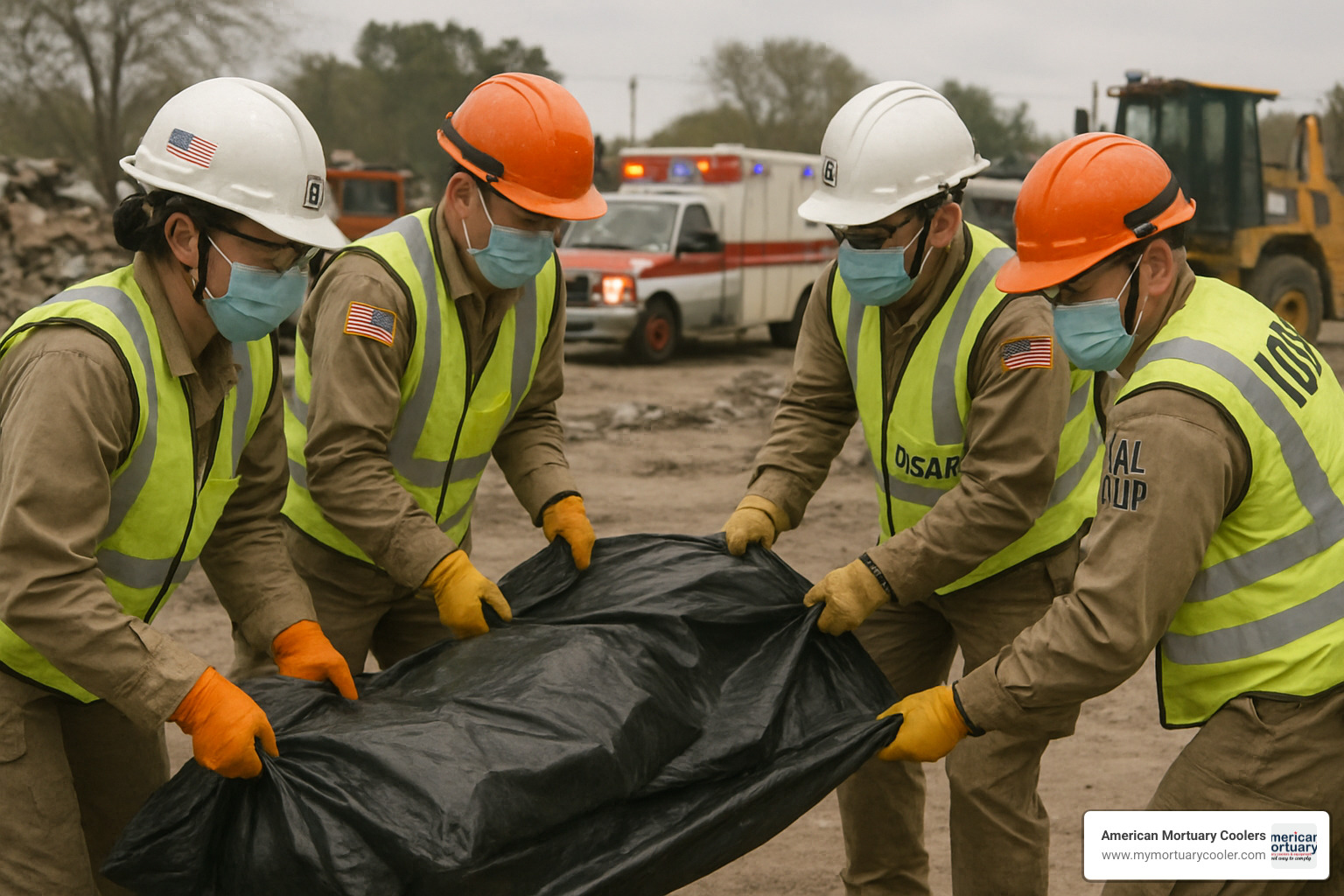
The WHO guidelines for mass-casualty management emphasize proper containment systems. When refrigerated storage gets overwhelmed, properly sealed body bags provide temporary surge capacity while maintaining dignity and preventing health hazards. The identification systems become crucial for victim identification and family notification processes.
Key Types, Sizes & Specialty Variants
Dead body bags come in various sizes reflecting diverse needs of funeral homes, hospitals, and emergency responders. The foundation starts with standard adult sizes - most funeral homes use regular adult bags measuring 36" x 90" (91 cm x 229 cm), accommodating most adults up to 400 pounds. Heavy-duty models at 38" x 94" offer reinforced construction supporting 440-500 pounds.
Handle configuration indicates intended use. Standard bags have 4-6 handles, heavy-duty versions have 8-12 handles, while disaster response bags may have up to 18 handles. Veterinary applications use specialized dimensions for animal remains.
Choosing a Dead Body Bag for Bariatric & Pediatric Needs
Bariatric body bags require serious engineering upgrades, typically measuring 72" x 90" supporting up to 1000 pounds. They feature 16 strap handles with heavy-duty rivets, 20-25 mil material thickness, and reinforced seams.
Pediatric applications require precise sizing for dignity and containment integrity. Pediatric sizes range from premie bags at 50 cm x 100 cm through infant, child (70 cm x 140 cm), and juvenile sizes.
| Size Category | Dimensions | Weight Capacity | Handle Count |
|---|---|---|---|
| Standard Adult | 36" x 90" | 400 lbs | 4-6 handles |
| Heavy Duty | 38" x 94" | 500 lbs | 8-12 handles |
| Bariatric | 72" x 90" | 1000 lbs | 16+ handles |
| Child | 70cm x 140cm | N/A | 4 handles |
Specialty Dead Body Bag Options for Infection Control
The COVID-19 pandemic emphasized specialized solutions for infectious disease scenarios requiring BSL-4 (Biosafety Level 4) standards. Hermetic sealing systems create completely airtight barriers, with some systems like BodySealer eliminating refrigerated storage needs.
Multi-layer construction incorporates foil laminate barriers preventing gas and odor transmission. These bags undergo pressure testing up to 4000 PSI for leak resistance. OSHA Regulation 3130 compliance is essential for protecting staff from bloodborne pathogens.
For comprehensive guidance, check out All About Body Bags: Understanding Their Usage.
Materials & Design Features That Matter
When selecting a dead body bag, materials and construction details determine reliability. PVC (Polyvinyl Chloride) remains the most popular choice, available in 6-25 mil thicknesses, offering excellent durability and fluid resistance.
PEVA (Polyethylene Vinyl Acetate) serves as the environmentally conscious alternative, performing nearly as well as PVC while meeting EPA chlorine-free burn requirements. LDPE (Low-Density Polyethylene) bags offer budget-friendly options at 200-micron thickness for standard situations.
For maximum strength, reinforced nylon combinations support weights up to 1000 pounds and resist punctures. Non-woven fabric options using 180 g/m² materials incinerate cleanly without environmental concerns.
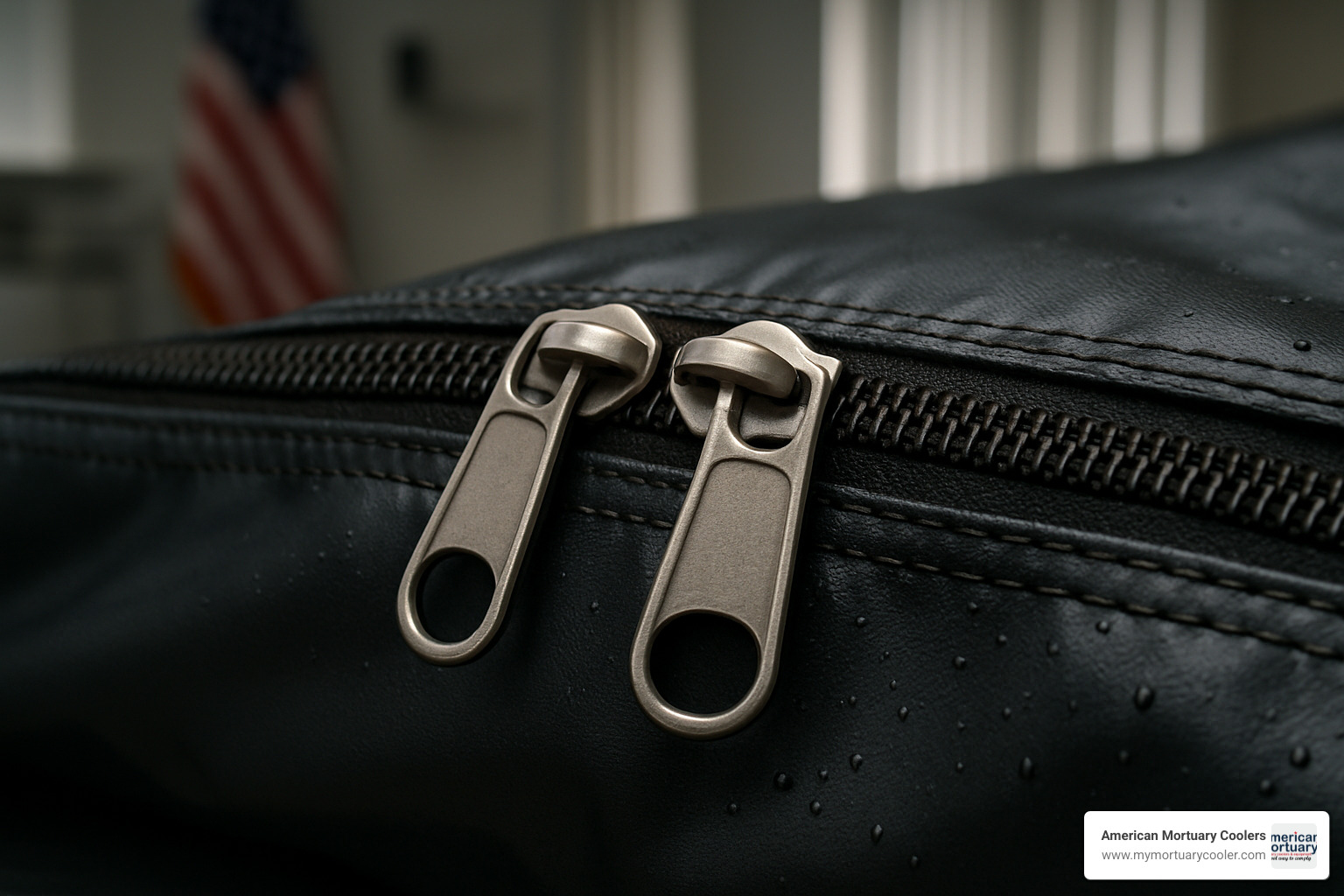
Design features matter equally. Zipper systems come in center-zip (full-length access) and envelope-zip (better containment) configurations. Handle placement using polypropylene webbing distributes weight evenly. Identification systems include transparent A5 windows and proper toe tag attachments.
The best bags use heat-sealed seams rather than sewn ones, creating superior leak-proof barriers. Dielectrically sealed seams offer maximum fluid containment for demanding situations.
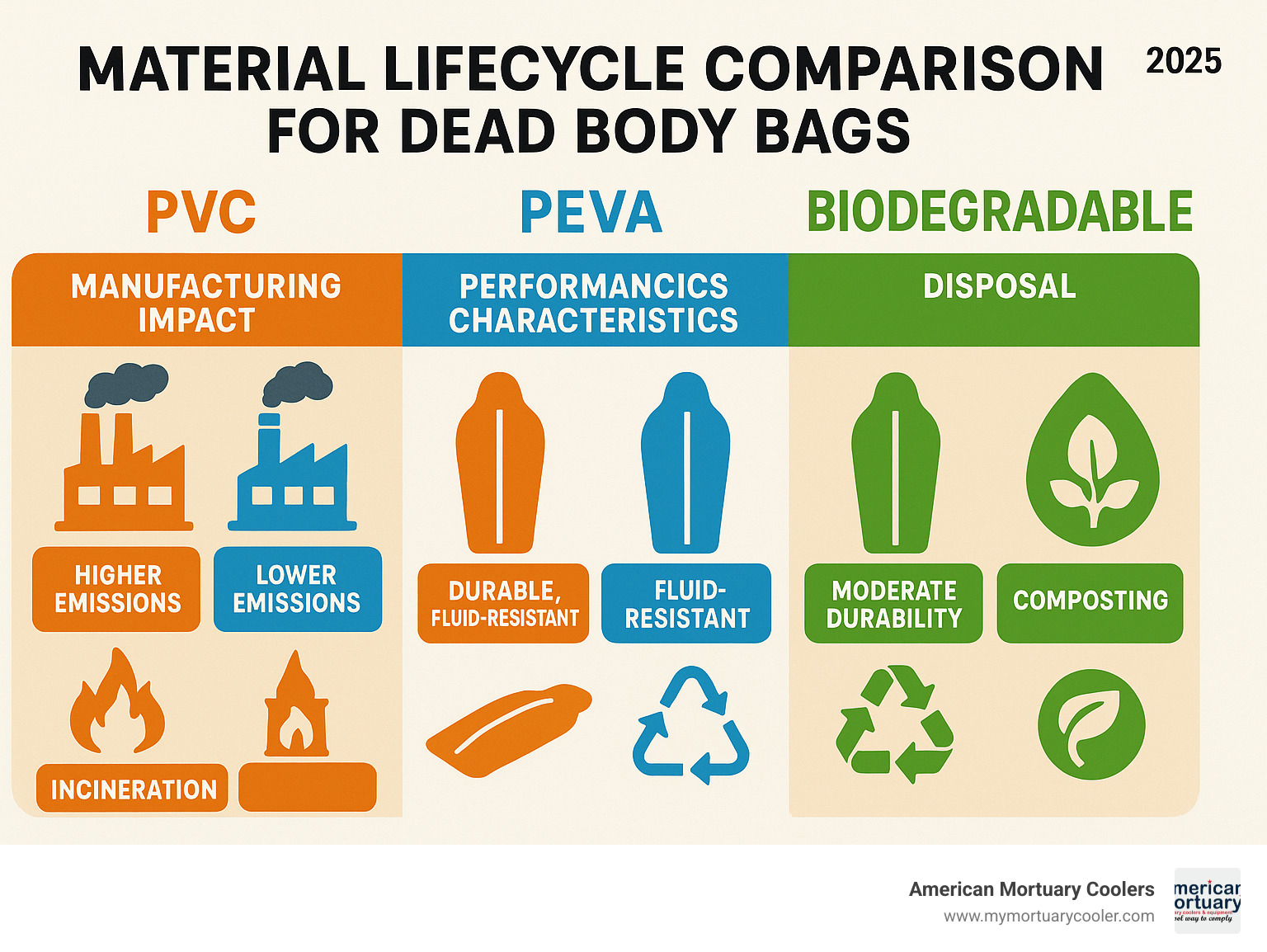
Dead Body Bag Price Breakdowns by Material
Basic LDPE bags run $1.04-$2.50 per unit for economy applications. Standard PVC bags fall in the $2.50-$5.00 range, representing the most common industry choice. Heavy-duty reinforced options cost $5.00-$8.50 per unit for demanding applications. Specialty bio-containment bags start at $8.50 and up.
Volume purchasing offers 15-30% savings over individual purchases. Case quantities typically contain 10-25 units. Supply chain dynamics can cause price fluctuations during peak demand periods.
For detailed pricing strategies, check out Mortuary Body Bags: Affordable Options and Prices. Amazon's Sustainability initiatives provide insight into environmental considerations alongside cost factors.
Safety, Compliance & Environmental Considerations
Working with dead body bags requires navigating safety rules protecting staff and community. OSHA Regulation 3130 sets the foundation for bloodborne pathogen protection, requiring genuine leak-proof construction. WHO infection control guidelines are crucial when handling remains from individuals with communicable diseases.
Environmental regulations add complexity. EPA burn requirements emphasize chlorine-free incineration, while IATA air transport regulations govern shipping remains by air. UN biohazard symbols and proper labeling protect everyone in the chain of custody.

Dead body bags are single-use only - never wash or reuse them. This prevents cross-contamination and protects forensic evidence integrity. Staff safety requires proper vaccination, PPE protocols including gloves, surgical masks, goggles, and protective clothing.
Handling & Storage Protocols for Dead Body Bags
Ten essential safety precautions create comprehensive protection. Staff preparation begins with appropriate vaccinations and waterproof wound coverings. Equipment removal involves disposing of all medical tubes, drains, and sharp objects before bagging.
Body preparation includes proper cleaning, drying, and wrapping before bag placement. For infectious cases, double-bagging provides additional security. Cold chain management remains important for most systems, though advanced hermetic systems may eliminate refrigeration needs.
Chain of custody documentation ensures legal compliance and accurate identification using ID windows and toe tag systems.
Disposal & Biodegradability
Environmental considerations increasingly influence selection. Biodegradable options from corn polymer blends offer environmental benefits while maintaining performance. Chlorine-free burn formulations eliminate harmful emissions during incineration.
Local regulations vary regarding disposal methods. Understanding requirements helps choose appropriate materials and disposal methods. For facilities pursuing sustainability initiatives, eco-friendly procurement supports environmental goals without compromising operations.
How to Buy a Dead Body Bag Online: Pricing, Suppliers & Lead Times
Shopping for dead body bags online has become the standard for most funeral homes. Digital procurement offers convenience through detailed catalogs, price comparisons, and office-based ordering.
Reputable suppliers offer comprehensive e-commerce platforms with high-resolution photos, material breakdowns, size charts, and performance ratings. Minimum order requirements vary - wholesale operations often require 500-1000 pieces for best pricing, while case quantities of 10-25 units offer volume discounts for smaller funeral homes.
Lead times during normal periods average 15 workdays, but can stretch to a month during peak seasons or unexpected events. Smart inventory management prevents just-in-time ordering challenges.
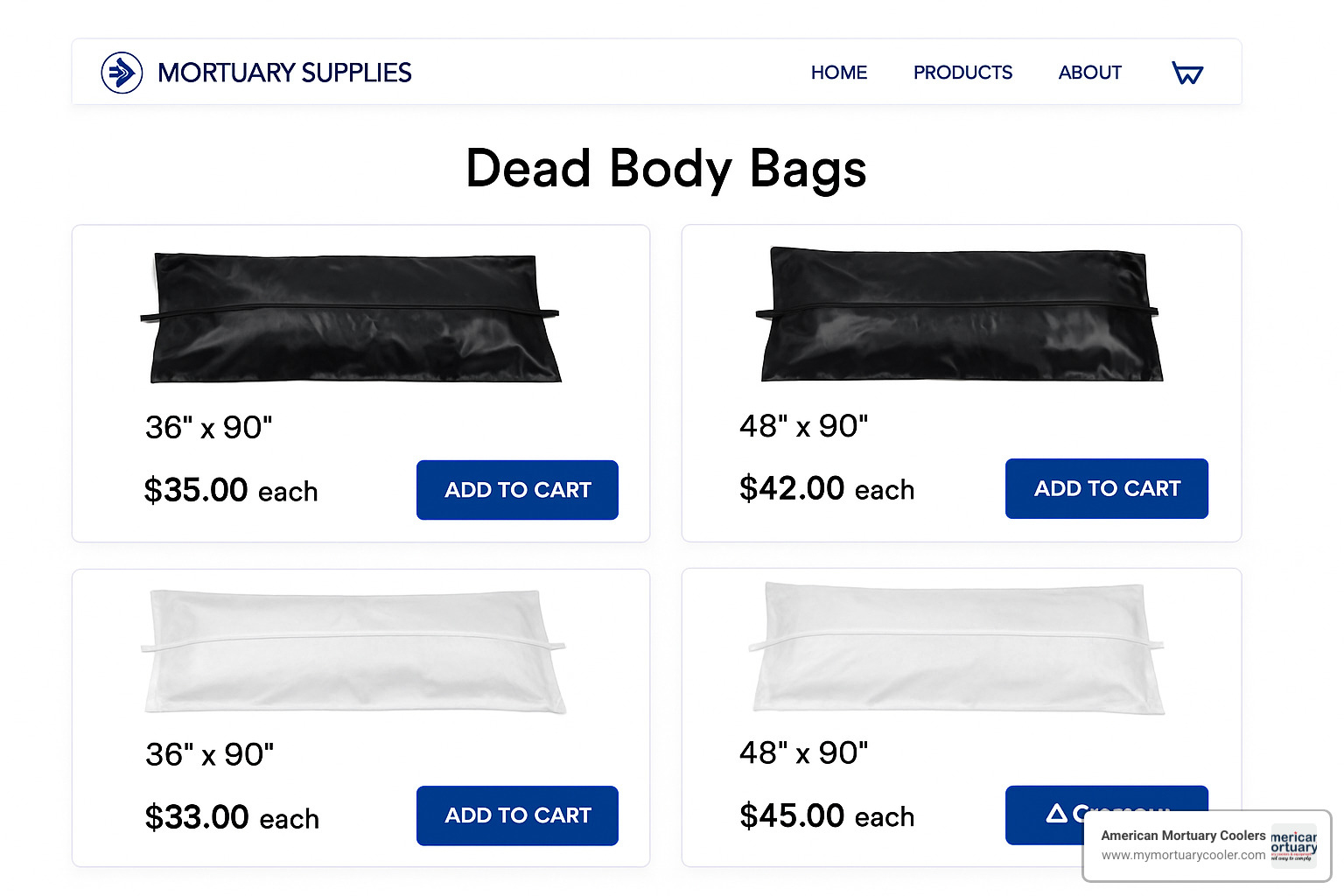
Shipping considerations matter due to considerable space and weight. Most suppliers offer delivery across the contiguous 48 states with varying shipping calculations. Payment security requires secure gateways, established credit terms, and purchase order capabilities.
Evaluating Supplier Credentials & Certifications
WHO approval represents the gold standard for international quality compliance. CE marking indicates European safety standard compliance. Audited factory status provides third-party manufacturing verification, while ISO certifications demonstrate quality management commitment.
Evaluate suppliers on response times (professional suppliers respond within 24 hours), transaction volume, and verified customer feedback. Warranty terms separate confident suppliers from corner-cutters.
For comprehensive guidance, refer to A Practical Guide to Buying Body Bags for Dead Bodies.
Dead Body Bag Bulk-Order Strategies for Funeral Homes
Smart procurement balances cost optimization with operational needs. Volume pricing offers 15-30% savings, making bulk orders attractive. Stock rotation using first-in-first-out systems prevents waste.
Surge buffer planning gained importance during COVID-19 supply disruptions. Many funeral homes now maintain 30-60 days additional inventory. Vendor agreements provide better pricing, favorable terms, and priority allocation during shortages.
Successful funeral homes treat procurement as part of overall supply chain strategy rather than one-off purchases.
Frequently Asked Questions about Dead Body Bags
Do dead body bags prevent or merely slow decomposition?
Dead body bags slow decomposition rather than preventing it entirely. Think of them as buying you precious time rather than stopping the clock completely.
The bags work through two main ways: cutting off oxygen and helping with temperature control. When you seal remains in a body bag, you create what's essentially a partial vacuum inside. This limits the aerobic bacteria that kick off the initial decomposition process. However, the anaerobic bacteria already living in the digestive tract keep working regardless of how little oxygen is available outside.
Timing makes all the difference here. The sooner you can get remains into a sealed bag after death, the better the oxygen restriction works. But even the best dead body bag needs to get to a temperature-controlled environment quickly. Heat buildup inside the bag actually speeds up bacterial activity, which defeats the purpose.
Some advanced systems like the BodySealer technology can eliminate the need for refrigeration entirely. These create completely airtight barriers that trap gases and prevent odor from escaping. They're the premium option when you need extended storage without refrigeration.
Can a dead body bag be reused after disinfection?
Absolutely not. Dead body bags should never be reused, even if you think you've cleaned them thoroughly. This isn't just about being extra cautious - there are serious safety and legal reasons behind this rule.
Body fluids have a way of getting into tiny porous areas or microscopic tears that you can't see. Even with the most thorough cleaning, these biological hazards can resist standard disinfection procedures. You're essentially playing Russian roulette with contamination risks.
The legal side gets even more complicated. In forensic situations, reusing bags could cross-contaminate evidence between cases. This contamination could compromise investigations and potentially make forensic evidence inadmissible in court. No case is worth that risk.
There's also the simple fact that the bag's structural integrity takes a hit after the first use. Stress points around zippers, seams, and handle attachments weaken. The last thing you want is a bag failing while your staff is moving it, creating a dangerous situation for everyone involved.
When you consider that body bags are relatively inexpensive compared to the massive risks of reuse, the single-use approach just makes sense. It's become the industry standard for good reason.
What size dead body bag should I keep in emergency kits?
For most emergency preparedness situations, standard adult size bags (36" x 90") give you the best bang for your buck. They'll handle the majority of adults while still being manageable for emergency personnel to work with.
That said, smart emergency planning means thinking about diversity. You don't want to be caught in a situation where your bags don't fit the people you need to help. A good rule of thumb is to stock 70% standard adult bags for most scenarios, 20% heavy duty or bariatric bags for larger individuals, and 10% pediatric bags in various child sizes.
Your local demographics should influence these percentages. If you're in an area with higher obesity rates, you might want to bump up that bariatric percentage. Communities with larger elderly populations might stick closer to standard sizing.
Storage matters for emergency kits too. Keep your bags in dry, temperature-controlled spaces away from direct sunlight. Quality dead body bags typically stay effective for three or more years when stored properly, making them perfect for long-term emergency preparedness planning.
The key is having options available when you need them most. Emergency situations are stressful enough without worrying about whether your equipment will do the job.
Conclusion
Choosing the right dead body bag becomes straightforward when you understand the basics. Match the product to your specific needs while keeping safety and compliance at the forefront.
Size matters more than you might think. Getting the right fit ensures dignity while providing containment integrity. Material choice depends on your situation - basic LDPE works for standard operations, while heavy-duty applications need reinforced options.
Don't skip compliance homework. OSHA, WHO, and EPA standards protect everyone - your staff, facility, and community. Stick with established suppliers having proper certifications like WHO approval and CE marking.
The cheapest option usually isn't the best value. Balance quality requirements with budget constraints, but cutting corners on safety equipment costs more long-term. Environmental considerations are increasingly important - eco-friendly alternatives don't compromise performance.
At American Mortuary Coolers, we see how mortuary equipment works together. Your cooling systems, storage solutions, and dead body bags all contribute to professional, dignified service. We've built our reputation understanding these connections and helping funeral homes get the right equipment.
Remember the fundamentals: safety first, proper sizing, quality materials, and reliable suppliers. Follow these principles for purchasing decisions that protect your staff and serve families well.
Whether running a small family operation or managing a large facility, these guidelines steer you toward smart dead body bag purchases meeting regulations, fitting budgets, and supporting professional service commitments.
For more information about mortuary equipment and supplies, including custom solutions designed for your specific needs, visit More info about body-bag products. Our team understands the funeral industry's unique challenges and stands ready to help with the same dedication to quality that has made us a trusted partner across the country.



